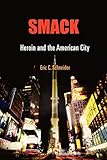Smack : Heroin and the American City / Eric C. Schneider.
Material type: TextSeries: Politics and Culture in Modern AmericaPublisher: Philadelphia : University of Pennsylvania Press, [2013]Copyright date: ©2009Description: 1 online resource (280 p.) : 14 illusContent type:
TextSeries: Politics and Culture in Modern AmericaPublisher: Philadelphia : University of Pennsylvania Press, [2013]Copyright date: ©2009Description: 1 online resource (280 p.) : 14 illusContent type: - 9780812221800
- 9780812203486
- Drug control -- United States -- History
- Drug traffic -- United States -- History
- HISTORY -- United States -- 20th century
- Heroin abuse -- United States -- History
- History -- 20th century
- Minorities -- Substance use -- United States -- History
- Minorities -- Substance use
- Minorities -- Substance use -- United States -- History
- Minorities -- Substance use
- American Studies
- HISTORY / United States / 20th Century
- American History
- American Studies
- Urban Studies
- 362.29/320973 23
- HV5822.H4
- online - DeGruyter
- Issued also in print.
| Item type | Current library | Call number | URL | Status | Notes | Barcode | |
|---|---|---|---|---|---|---|---|
 eBook
eBook
|
Biblioteca "Angelicum" Pont. Univ. S.Tommaso d'Aquino Nuvola online | online - DeGruyter (Browse shelf(Opens below)) | Online access | Not for loan (Accesso limitato) | Accesso per gli utenti autorizzati / Access for authorized users | (dgr)9780812203486 |
Browsing Biblioteca "Angelicum" Pont. Univ. S.Tommaso d'Aquino shelves, Shelving location: Nuvola online Close shelf browser (Hides shelf browser)

|

|

|

|

|

|

|
||
| online - DeGruyter Used Books : Marking Readers in Renaissance England / | online - DeGruyter Beyond the Farm : National Ambitions in Rural New England / | online - DeGruyter Christianity, Empire, and the Making of Religion in Late Antiquity / | online - DeGruyter Smack : Heroin and the American City / | online - DeGruyter Protestant Empire : Religion and the Making of the British Atlantic World / | online - DeGruyter Culture and Belonging in Divided Societies : Contestation and Symbolic Landscapes / | online - DeGruyter Gray Panthers / |
Frontmatter -- CONTENTS -- INTRODUCTION: REQUIEM FOR THE CITY -- CHAPTER ONE. New York and the Global Market -- CHAPTER TWO. Jazz Joints and Junk -- CHAPTER THREE. The Plague -- CHAPTER FOUR. The Panic over Adolescent Heroin Use -- CHAPTER FIVE. Ethnicity and the Market -- CHAPTER SIX. The Rising Tide -- CHAPTER SEVEN. Dealing with Dope -- CHAPTER EIGHT. Heroin Suburbanizes -- CHAPTER NINE. The War and the War at Home -- CHAPTER TEN. From the Golden Spike to the Glass Pipe -- CONCLUSION. Heroin Markets Redux -- NOTES -- INDEX -- ACKNOWLEDGMENTS
restricted access online access with authorization star
http://purl.org/coar/access_right/c_16ec
Why do the vast majority of heroin users live in cities? In his provocative history of heroin in the United States, Eric C. Schneider explains what is distinctively urban about this undisputed king of underworld drugs.During the twentieth century, New York City was the nation's heroin capital-over half of all known addicts lived there, and underworld bosses like Vito Genovese, Nicky Barnes, and Frank Lucas used their international networks to import and distribute the drug to cities throughout the country, generating vast sums of capital in return. Schneider uncovers how New York, as the principal distribution hub, organized the global trade in heroin and sustained the subcultures that supported its use.Through interviews with former junkies and clinic workers and in-depth archival research, Schneider also chronicles the dramatically shifting demographic profile of heroin users. Originally popular among working-class whites in the 1920s, heroin became associated with jazz musicians and Beat writers in the 1940s. Musician Red Rodney called heroin the trademark of the bebop generation. "It was the thing that gave us membership in a unique club," he proclaimed. Smack takes readers through the typical haunts of heroin users-52nd Street jazz clubs, Times Square cafeterias, Chicago's South Side street corners-to explain how young people were initiated into the drug culture.Smack recounts the explosion of heroin use among middle-class young people in the 1960s and 1970s. It became the drug of choice among a wide swath of youth, from hippies in Haight-Ashbury and soldiers in Vietnam to punks on the Lower East Side. Panics over the drug led to the passage of increasingly severe legislation that entrapped heroin users in the criminal justice system without addressing the issues that led to its use in the first place. The book ends with a meditation on the evolution of the war on drugs and addresses why efforts to solve the drug problem must go beyond eliminating supply.
Issued also in print.
Mode of access: Internet via World Wide Web.
In English.
Description based on online resource; title from PDF title page (publisher's Web site, viewed 24. Apr 2022)


